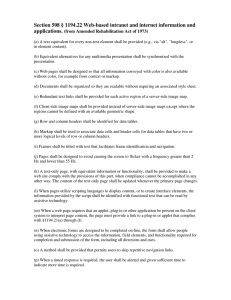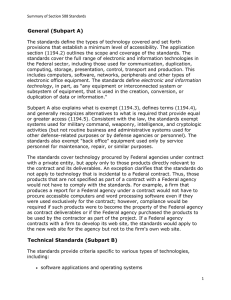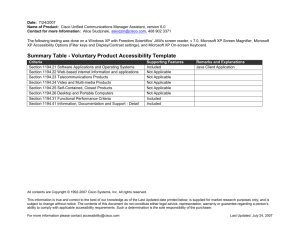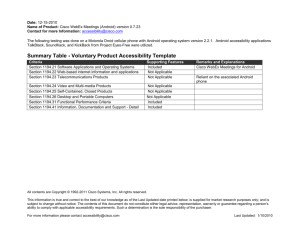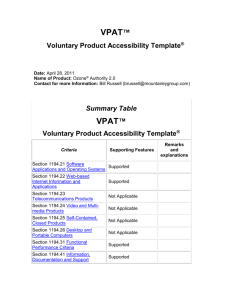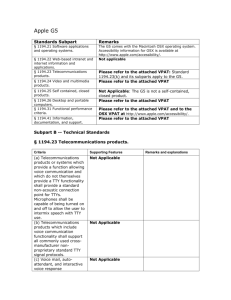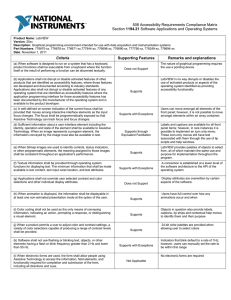Date: Name of Product: Contact for more Information:
advertisement
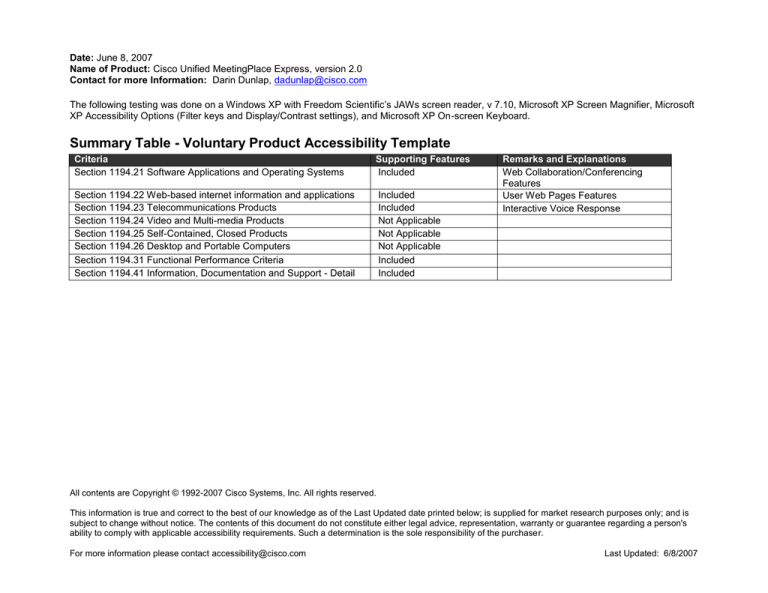
Date: June 8, 2007 Name of Product: Cisco Unified MeetingPlace Express, version 2.0 Contact for more Information: Darin Dunlap, dadunlap@cisco.com The following testing was done on a Windows XP with Freedom Scientific’s JAWs screen reader, v 7.10, Microsoft XP Screen Magnifier, Microsoft XP Accessibility Options (Filter keys and Display/Contrast settings), and Microsoft XP On-screen Keyboard. Summary Table - Voluntary Product Accessibility Template Criteria Section 1194.21 Software Applications and Operating Systems Supporting Features Included Section 1194.22 Web-based internet information and applications Section 1194.23 Telecommunications Products Section 1194.24 Video and Multi-media Products Section 1194.25 Self-Contained, Closed Products Section 1194.26 Desktop and Portable Computers Section 1194.31 Functional Performance Criteria Section 1194.41 Information, Documentation and Support - Detail Included Included Not Applicable Not Applicable Not Applicable Included Included Remarks and Explanations Web Collaboration/Conferencing Features User Web Pages Features Interactive Voice Response All contents are Copyright © 1992-2007 Cisco Systems, Inc. All rights reserved. This information is true and correct to the best of our knowledge as of the Last Updated date printed below; is supplied for market research purposes only; and is subject to change without notice. The contents of this document do not constitute either legal advice, representation, warranty or guarantee regarding a person's ability to comply with applicable accessibility requirements. Such a determination is the sole responsibility of the purchaser. For more information please contact accessibility@cisco.com Last Updated: 6/8/2007 Section 1194.21: Software Applications and Operating Systems – Detail Cisco Unified MeetingPlace Express 2.0 (Web Collaboration/Conferencing – Meeting Window) 508 Clause Criteria Supporting Features 1194.21(a) When software is designed to run on a system that has a keyboard, product functions shall be executable from a keyboard where the function itself or the result of performing a function can be discerned textually. Not Supported 1194.21(b) Applications shall not disrupt or disable activated features of other products that are identified as accessibility features, where those features are developed and documented according to industry standards. Applications also shall not disrupt or disable activated features of any operating system that are identified as accessibility features where the application programming interface for those accessibility features has been documented by the manufacturer of the operating system and is available to the product developer. A well-defined on-screen indication of the current focus shall be provided that moves among interactive interface elements as the input focus changes. The focus shall be programmatically exposed so that Assistive Technology can track focus and focus changes. Sufficient information about a user interface element including the identity, operation and state of the element shall be available to Assistive Technology. When an image represents a program element, the information conveyed by the image must also be available in text. Not Supported When bitmap images are used to identify controls, status indicators, or other programmatic elements, the meaning assigned to those images shall be consistent throughout an application's performance. Not Supported 1194.21(c) 1194.21(d) 1194.21(e) Remarks and Explanations Not Supported Not Supported All contents are Copyright © 1992-2007 Cisco Systems, Inc. All rights reserved. This information is true and correct to the best of our knowledge as of the Last Updated date printed below; is supplied for market research purposes only; and is subject to change without notice. The contents of this document do not constitute either legal advice, representation, warranty or guarantee regarding a person's ability to comply with applicable accessibility requirements. Such a determination is the sole responsibility of the purchaser. For more information please contact accessibility@cisco.com Last Updated: 6/8/2007 1194.21(f) Textual information shall be provided through operating system functions for displaying text. The minimum information that shall be made available is text content, text input caret location, and text attributes. Not Supported 1194.21(g) Applications shall not override user selected contrast and color selections and other individual display attributes. When animation is displayed, the information shall be displayable in at least one non-animated presentation mode at the option of the user. Not Supported 1194.21(i) Color coding shall not be used as the only means of conveying information, indicating an action, prompting a response, or distinguishing a visual element. Supported 1194.21(j) When a product permits a user to adjust color and contrast settings, a variety of color selections capable of producing a range of contrast levels shall be provided. Partially Supported 1194.21(k) Software shall not use flashing or blinking text, objects, or other elements having a flash or blink frequency greater than 2 Hz and lower than 55 Hz. Supported 1194.21(l) When electronic forms are used, the form shall allow people using Assistive Technology to access the information, field elements, and functionality required for completion and submission of the form, including all directions and cues. Not Supported 1194.21(h) Not applicable No animations Not all content inherits these settings. All contents are Copyright © 1992-2007 Cisco Systems, Inc. All rights reserved. This information is true and correct to the best of our knowledge as of the Last Updated date printed below; is supplied for market research purposes only; and is subject to change without notice. The contents of this document do not constitute either legal advice, representation, warranty or guarantee regarding a person's ability to comply with applicable accessibility requirements. Such a determination is the sole responsibility of the purchaser. For more information please contact accessibility@cisco.com Last Updated: 6/8/2007 Section 1194.22 Web-based internet information and applications – Detail Cisco Unified MeetingPlace Express 2.0 (User Web Pages for administering meetings) 508 Clause Criteria Status 1194.22(a) 1194.22(b) 1194.22(c) 1194.22(d) 1194.22(e) 1194.22(f) 1194.22(g) 1194.22(h) 1194.22(i) 1194.22(j) Remarks and Explanations A text equivalent for every non-text element shall be provided (e.g., via "alt", "longdesc", or in element content). Equivalent alternatives for any multimedia presentation shall be synchronized with the presentation. Web pages shall be designed so that all information conveyed with color is also available without color, for example from context or markup. Supports with Exceptions Some icons in scheduling and calendar do not have text equivalents. Not Applicable No multimedia presentations. Documents shall be organized so they are readable without requiring an associated style sheet. Redundant text links shall be provided for each active region of a server-side image map. Client-side image maps shall be provided instead of server-side image maps except where the regions cannot be defined with an available geometric shape. Row and column headers shall be identified for data tables. Markup shall be used to associate data cells and header cells for data tables that have two or more logical levels of row or column headers. Supports Frames shall be titled with text that facilitates frame identification and navigation. Pages shall be designed to avoid causing the screen to flicker with a frequency greater than 2 Hz and lower than 55 Hz. Not Applicable Supports Not Applicable Not Applicable No server-side images maps in product. No client-side images maps in product. Supports Not Applicable No Frames Supports All contents are Copyright © 1992-2007 Cisco Systems, Inc. All rights reserved. This information is true and correct to the best of our knowledge as of the Last Updated date printed below; is supplied for market research purposes only; and is subject to change without notice. The contents of this document do not constitute either legal advice, representation, warranty or guarantee regarding a person's ability to comply with applicable accessibility requirements. Such a determination is the sole responsibility of the purchaser. For more information please contact accessibility@cisco.com Last Updated: 6/8/2007 1194.22(k) 1194.22(l) 1194.22(m) 1194.22(n) A text-only page, with equivalent information or functionality, shall be provided to make a web site comply with the provisions of this part, when compliance cannot be accomplished in any other way. The content of the text-only page shall be updated whenever the primary page changes. When pages utilize scripting languages to display content, or to create interface elements, the information provided by the script shall be identified with functional text that can be read by assistive technology. Not Applicable No text-only page is needed or provided. Supports with Exceptions When a web page requires that an applet, plug-in or other application be present on the client system to interpret page content, the page must provide a link to a plug-in or applet that complies with §1194.21(a) through (l). When electronic forms are designed to be completed on-line, the form shall allow people using assistive technology to access the information, field elements, and functionality required for completion and submission of the form, including all directions and cues. Not Applicable Exceptions when JavaScript turned off: 1. "Attend," "Find," "Profile," and "Log Out" links not operable. 2. "Log In" button results in error message. 3. Attend: "OK" button not operable. 4. Attend and Start Reservationless: "Browser Test" link not operable. 5. Schedule: "Invitees" and "More Options" links not operable. 6. Schedule: "Schedule Meeting" button schedules the meeting but the user does not receive confirmation. 7. Start Reservationless: "Join Meeting" button results in an error message. 8. Profile: "Cancel" button functions as "Update Profile" button. No instances of an applet. Supports with Exceptions Schedule Meeting: The text box for entering the minutes component of the "Duration" option has no implicit label. All contents are Copyright © 1992-2007 Cisco Systems, Inc. All rights reserved. This information is true and correct to the best of our knowledge as of the Last Updated date printed below; is supplied for market research purposes only; and is subject to change without notice. The contents of this document do not constitute either legal advice, representation, warranty or guarantee regarding a person's ability to comply with applicable accessibility requirements. Such a determination is the sole responsibility of the purchaser. For more information please contact accessibility@cisco.com Last Updated: 6/8/2007 1194.22(o) A method shall be provided that permits users to skip repetitive navigation links. Not Applicable 1194.22(p) When a timed response is required, the user shall be alerted and given sufficient time to indicate more time is required. Not Applicable Very minimal repetitive Navigation links; Skip Navigation option is not needed. No timed responses. All contents are Copyright © 1992-2007 Cisco Systems, Inc. All rights reserved. This information is true and correct to the best of our knowledge as of the Last Updated date printed below; is supplied for market research purposes only; and is subject to change without notice. The contents of this document do not constitute either legal advice, representation, warranty or guarantee regarding a person's ability to comply with applicable accessibility requirements. Such a determination is the sole responsibility of the purchaser. For more information please contact accessibility@cisco.com Last Updated: 6/8/2007 Section 1194.23 Telecommunications Products MeetingPlace Express, version 2.0, Telephone User Interface Clause Criteria 1194.23(a) Telecommunications products or systems which provide a function allowing voice communication and which do not themselves provide a TTY functionality shall provide a standard nonacoustic connection point for TTYs. Microphones shall be capable of being turned on and off to allow the user to intermix speech with TTY use. 1194.23(b) Telecommunications products which include voice communication functionality shall support all commonly used cross-manufacturer nonproprietary standard TTY signal protocols. 1194.23(c) 1194.23(d) 1194.23(e) 1194.23(f) Voice mail, auto-attendant, and interactive voice response telecommunications systems shall be usable by TTY users with their TTYs. Voice mail, messaging, auto-attendant, and interactive voice response telecommunications systems that require a response from a user within a time interval, shall give an alert when the time interval is about to run out, and shall provide sufficient time for the user to indicate more time is required. Where provided, caller identification and similar telecommunications functions shall also be available for users of TTYs, and for users who cannot see displays. For transmitted voice signals, telecommunications products shall provide a gain adjustable up to a minimum of 20 dB. For incremental volume control, at least one intermediate step of 12 dB of gain shall be provided. Status Not applicable Comments Not applicable Not applicable Supports with Exceptions There is a 7 second timeout during an inactive prompt. There is the feature to repeat a prompt after pausing for input. A user has the option to repeat the pattern at least twice. Not applicable Not applicable All contents are Copyright © 1992-2007 Cisco Systems, Inc. All rights reserved. This information is true and correct to the best of our knowledge as of the Last Updated date printed below; is supplied for market research purposes only; and is subject to change without notice. The contents of this document do not constitute either legal advice, representation, warranty or guarantee regarding a person's ability to comply with applicable accessibility requirements. Such a determination is the sole responsibility of the purchaser. For more information please contact accessibility@cisco.com Last Updated: 6/8/2007 1194.23(g) 1194.23(h) 1194.23(i) 1194.23(j) 1194.23(k1) 1194.23(k2) If the telecommunications product allows a user to adjust the receive volume, a function shall be provided to automatically reset the volume to the default level after every use. Where a telecommunications product delivers output by an audio transducer which is normally held up to the ear, a means for effective magnetic wireless coupling to hearing technologies shall be provided. Interference to hearing technologies (including hearing aids, cochlear implants, and assistive listening devices) shall be reduced to the lowest possible level that allows a user of hearing technologies to utilize the telecommunications product. Products that transmit or conduct information or communication, shall pass through crossmanufacturer, non-proprietary, industrystandard codes, translation protocols, formats or other information necessary to provide the information or communication in a usable format. Technologies which use encoding, signal compression, format transformation, or similar techniques shall not remove information needed for access or shall restore it upon delivery. Products which have mechanically operated controls or keys shall comply with the following: Controls and Keys shall be tactilely discernible without activating the controls or keys. Products which have mechanically operated controls or keys shall comply with the following: Controls and Keys shall be operable with one hand and shall not require tight grasping, pinching, twisting of the wrist. The force required to activate controls and keys shall be 5 lbs. (22.2N) maximum. Not applicable Not applicable Not applicable Not applicable Not applicable Not applicable All contents are Copyright © 1992-2007 Cisco Systems, Inc. All rights reserved. This information is true and correct to the best of our knowledge as of the Last Updated date printed below; is supplied for market research purposes only; and is subject to change without notice. The contents of this document do not constitute either legal advice, representation, warranty or guarantee regarding a person's ability to comply with applicable accessibility requirements. Such a determination is the sole responsibility of the purchaser. For more information please contact accessibility@cisco.com Last Updated: 6/8/2007 1194.23(k3) 1194.23(k4) Products which have mechanically operated controls or keys shall comply with the following: If key repeat is supported, the delay before repeat shall be adjustable to at least 2 seconds. Key repeat rate shall be adjustable to 2 seconds per character. Products which have mechanically operated controls or keys shall comply with the following: The status of all locking or toggle controls or keys shall be visually discernible, and discernible either through touch or sound. Not applicable Not applicable All contents are Copyright © 1992-2007 Cisco Systems, Inc. All rights reserved. This information is true and correct to the best of our knowledge as of the Last Updated date printed below; is supplied for market research purposes only; and is subject to change without notice. The contents of this document do not constitute either legal advice, representation, warranty or guarantee regarding a person's ability to comply with applicable accessibility requirements. Such a determination is the sole responsibility of the purchaser. For more information please contact accessibility@cisco.com Last Updated: 6/8/2007 Section 1194.31: Functional Performance Criteria - Detail 508 Clause Criteria Supporting Features 1194.31(a) At least one mode of operation and information retrieval that does not require user vision shall be provided, or support for Assistive Technology used by people who are blind or visually impaired shall be provided. Compatibility with screen readers in content and functionality. 1194.31(b) At least one mode of operation and information retrieval that does not require visual acuity greater than 20/70 shall be provided in audio and enlarged print output working together or independently, or support for Assistive Technology used by people who are visually impaired shall be provided. 1194.31(c) At least one mode of operation and information retrieval that does not require user hearing shall be provided, or support for Assistive Technology used by people who are deaf or hard of hearing shall be provided Compatibility with screen magnifiers in content and functionality. Low use of graphics. Highly readable text fonts and contrast. No auditory-only content or functionality. 1194.31(d) Where audio information is important for the use of a product, at least one mode of operation and information retrieval shall be provided in an enhanced auditory fashion, or support for assistive hearing devices shall be provided. At least one mode of operation and information retrieval that does not require user speech shall be provided, or support for Assistive Technology used by people with disabilities shall be provided. At least one mode of operation and information retrieval that does not require fine motor control or simultaneous actions and that is operable with limited reach and strength shall be provided. 1194.31(e) 1194.31(f) No auditory-only content or functionality. Remarks and Explanations Web User Interface supports Web Collaboration Does Not Support All tasks in Web User Interface can be performed visually. In the Web Collaboration user can have recorded meeting transcribed separately. All tasks in Web User Interface can be performed visually. No speech-driven content or functionality. Compatible with operating system utilities for keyboard and alternate input. Web User Interface supports Web Collaboration Does Not Support All contents are Copyright © 1992-2007 Cisco Systems, Inc. All rights reserved. This information is true and correct to the best of our knowledge as of the Last Updated date printed below; is supplied for market research purposes only; and is subject to change without notice. The contents of this document do not constitute either legal advice, representation, warranty or guarantee regarding a person's ability to comply with applicable accessibility requirements. Such a determination is the sole responsibility of the purchaser. For more information please contact accessibility@cisco.com Last Updated: 6/8/2007 Section 1194.41: Information, Documentation and Support 508 Clause Criteria Supporting Features 1194.41(a) Product support documentation provided to end-users shall be made available in alternate formats upon request, at no additional charge Supports 1194.41(b) End-users shall have access to a description of the accessibility and compatibility features of products in alternate formats or alternate methods upon request, at no additional charge. Support services for products shall accommodate the communication needs of end-users with disabilities. Not supported 1194.41(c) Supports Remarks and Explanations Accessible documentation is available through Cisco Technical Assistance Center (TAC) upon request. Cisco conforms through equal facilitation. Customers may reach Cisco Technical Assistance Center (TAC) via Phone, Email or Web Form. All cases open through email or web are opened as Priority 3 cases. All Priority 1 or Priority 2 case can only be opened via the telephone. TTY users can contact Cisco TAC via TRS. All contents are Copyright © 1992-2007 Cisco Systems, Inc. All rights reserved. This information is true and correct to the best of our knowledge as of the Last Updated date printed below; is supplied for market research purposes only; and is subject to change without notice. The contents of this document do not constitute either legal advice, representation, warranty or guarantee regarding a person's ability to comply with applicable accessibility requirements. Such a determination is the sole responsibility of the purchaser. For more information please contact accessibility@cisco.com Last Updated: 6/8/2007
